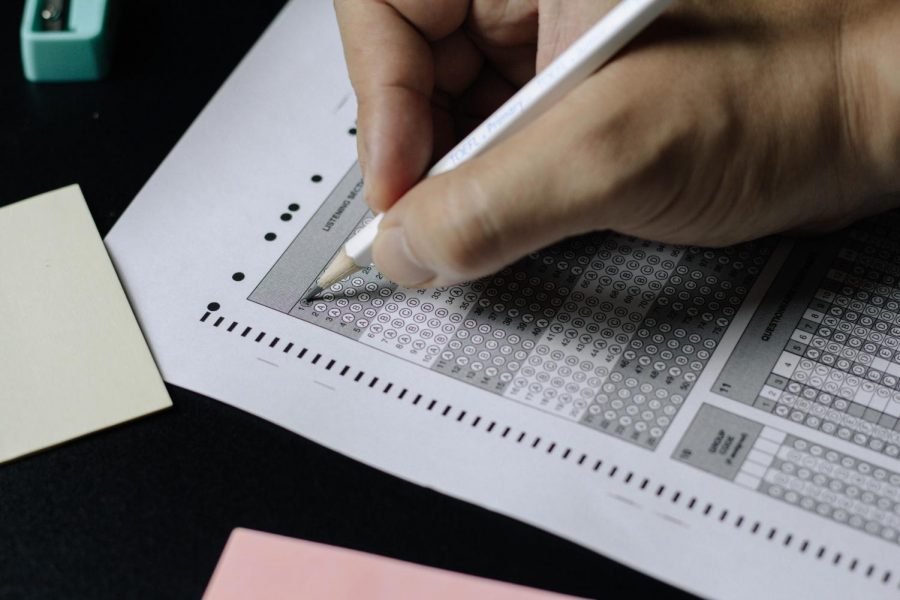AP exams will be offered in virtual and in-person settings
AP exams are usually taken in a large test booklet that students write in, but with virtual AP exams, its harder to do some types of questions, especially ones that require students to show work.
March 1, 2021
With the recent MCPS decision to return to in-person school, students and teachers alike are now having to adjust to the reality of changing plans and finishing school in-person. Early in the year many teachers and students adopted the pessimistic view that this year of school would be fully virtual. Now that this may not be the case, students and teachers have been grappling with another important decision regarding AP exams.
“The College Board is offering a variety of settings to take the exam,” Paul Dermont, an art teacher at WCHS, said. “For example, there is a sitting on Thursday, May 6th at 3:00 for an in-school paper and pencil edition of the AP Art History exam. On Wednesday, May 19th there is a digital version of the exam that can be taken at home or at school. We will need to wait on the decisions made by the administration about when and how the exams will be offered.”
Taking AP exams in person is now a viable option, and even mandatory for certain courses, but with students so used to learning online and being able to use notes during tests, taking AP exams without notes and in-person will be a lot to adjust to. Students have worked hard to adapt to virtual learning and it’s no doubt going to be a challenge when they return to in-person school every weekday for six hours.
“It is hard to tell [how AP exams will look] because of the way circumstances are at the moment but I am hoping that they will be virtual,” WCHS junior Emel Zuberi said.
It’s also important to consider the health factors that impact students’ decisions regarding testing, as some students and their loved ones are more susceptible to COVID-19. Most of the plans for returning to any in-person activities are reliant on the quick distribution of vaccines, which is not the case in many parts of the country.
“I would feel much more comfortable taking the AP exam in person once I know that the majority of students and faculty members are vaccinated and the number of COVID cases are decreasing,” Zuberi said.
Despite the uncertainty surrounding how AP exams will be administered, another area of interest regarding exams is the content. Last year, due to the COVID-19 pandemic, AP exams were shortened and tested students on fewer topics due to the quarantine during the second semester. Even though students have been going to school since September this year, many classes are still finding themselves behind where the College Board says students should be instructionally.
“I think that the College Board should definitely make it challenging but adhere to the amount of information that we have learned throughout the year,” Zuberi said. “This is because it is hard to learn all the content in an AP course online.”
There is a fine line between making a course challenging and making it unreasonable. With virtual school it’s important for institutions like the College Board to reevaluate what’s possible for students to learn in two hours a week as opposed to the average four hours a week that students have in each class when school is in-person.
“I think that I am doing the best that I can to prepare in a virtual setting but obviously it is hard since you are not learning as much as you would in person,” Zuberi said.
More often than not, teachers are relying on students to learn outside of the allotted two hours of instructional time each week. Instead of homework that helps students hone their abilities, some classes are assigning work on completely new subjects that students are expected to complete outside of class.
“I think the College Board will hold the students and teachers accountable for the entire content. Many teachers don’t follow the units of study in order so they may cover a unit that is toward the end of the course earlier. For example I taught the 9th unit (out of 10) on contemporary art right after unit 4’s coverage of modern art since I thought it fit better chronologically and conceptually,” Dermont said. “Unfortunately for my students, they cut this unit out of the exam. As a result my students had to quickly pivot and learn the remaining units asynchronously at home.”
Teachers are teaching courses that were designed to be taught on a normal, full school schedule in only two, one-hour sessions a week. Some teachers have more freedom to teach at a slower pace that benefits students while learning in a virtual classroom. But in AP classes, teachers need to follow a strict schedule, with the AP exam always looming overhead.
The College Board has done its best to aid students’ learning by releasing weekly videos to help prepare for AP exams. But so far they have not adjusted the curriculum of the AP classes or the corresponding exams.
“This year, the College Board has expanded its resources to include Daily Videos which teach a variety of analysis and writing strategies that would be normally taught in school,” Dermont said. “With only 2 hours of class time each week, these videos will be very helpful in providing these strategies. I am pretty confident that the students will do well this year if they utilize the resources available to them.”


